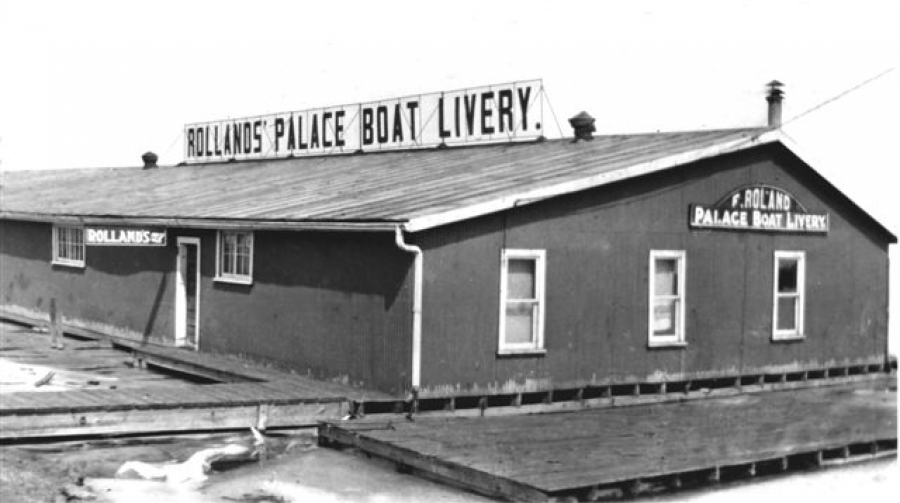The Palace boat Livery was established at the foot of Mississaga Street in 1900.
In 1899 three Rolland brothers and their families moved to Orillia from Gananoque, Ontario. One of the brothers, Frank, his wife Stephronia, two sons Harold and George and two daughters Violet and Helena, settled in a home at the corner of Colborne and Scott Streets.
Frank was a successful fishing guide on the St. Lawrence River and brought his 21 foot rowing boat with him. He continued his fishing and guide business in Orillia but soon realized he should have a boat livery to expand his business and in 1900 established the Palace Boat Livery at the foot of Misssissaga Street on the east side of the Grand Trunk railway tracks.From this location he continued to guide fishing parties and managed a booming rental business from a large inventory of canoes and row boats.
In 1912 the C.P.R. built a new rail bed along the waterfront. The shoreline had to be filled and extended and the existing boathouses were removed including the Palace Boat Livery. C.P.R. was required to replace all the demolished buildings and in 1914 the new Rolland Palace Boat Livery was built close to the new town wharf at the bottom of Mississaga Street. From this new livery Frank Rolland continued to rent rowboats and canoes.
The business continued to expand until disaster struck on April 14 1964. A serious fire destroyed the J. H. Ross Boat & Canoe Company located next door and demolished half of the Rolland boathouse as well as the Rolland cruise boat called "Miss Orillia". In 1966 Rolland Boats Ltd. moved to a new location on Highway 11, three miles north of Orillia. Harold's sons John and Neil continued to sell and service the marine industry until October 1987 when it was sold, ending close to 100 years of participation in the boat business for the Rolland family.
Looking for projects to generate income in the winter months, the Rolland family made oars, paddles, fishing decoys as well as baseball bats. In 1947 Harold purchased a lathe from Garfield Clark who was a machinist at the E. Long Co. and started manufacturing baseball bats. For the next four or five years Harold's son John made about 1500 bats every winter while his dad marketed them to local sporting goods stores and sports teams.
The lathe would turn white oak blocks of wood 3 inches square by 36 inches long into bats and after rubbing with oil would be rolled on a hot stamp engraved with the Rolland name. Harold Rolland was trained as an engraver before taking over his father business in 1930 and engraved his own template on a brass plate about 1/2" thick and 4" square.

